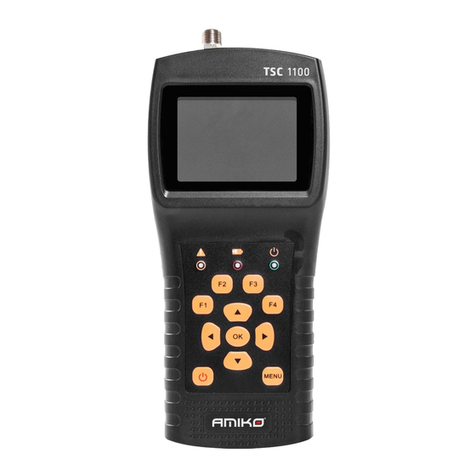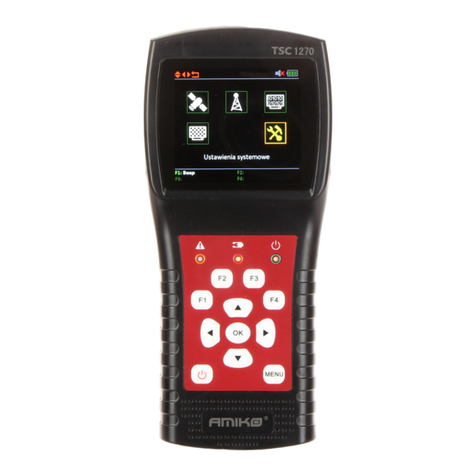
Press [F3] to add new satellite. Press [F4] to enter delete satellite dialog, and then press [OK] to confirm to delete
or press [MENU] to cancel.
Press [OK] to enter transponder list of current satellite.
User`s Manual
11 / 25
5.3
E
DIT
S
ATELLITE
The parameters of satellite, such as Orbit Position and
Transponder can be edit in this menu. All the satellites will
be listed in this menu.
Press [/] buttons to move curse in list.
Press [F2] button to edit the name or the orbit position of
current satellite in the dialog. And then press [/] to
move curse and [/] to change value of each focused
item in edit menu.
Press [F3] to add new satellite. Press [F4] to enter delete
satellite dialog, and then press [OK] to confirm to delete or
press [MENU] to cancel.
Press [OK] to enter transponder list of current satellite.
On transponder list menu, press [OK] or [F2] to edit
transponder. Press [F3] to add new transponder. Press [F4]
to enter delete dialog, press [OK] to confirm to delete or
press [MENU] to cancel. And press [OK] button to edit
selected transponder. And then press [/] to move
curse and [/] to change value of each focused item in edit menu.
5.4.
S
PECTRUM
C
HART
This menu will show the spectrum chart of setting
frequency range on current cable line. Press [/] to
switch curser focus between Start Frequency, End
Frequency, LNB Setting and Current Frequency Mark.
22K: Show the RF 22k status. The 22K
is on if the icon is green.
13V: Show the RF power output 13V status. The 13v output is on if the icon is
green.
18V: Show the RF power output 18V status. The 18v output is on if the icon is
green.
On transponder list menu, press [OK] or [F2] to edit transponder. Press [F3] to add new transponder. Press [F4] to
enter delete dialog, press [OK] to confirm to delete or press [MENU] to cancel. And press [OK] button to edit selected
transponder. And then press ◄/►to move curse and ▼/▲ to change value of each focused item in edit menu.
5.4. SPECTRUM CHART
This menu will show the spectrum chart of setting frequency range on current cable line. Press
▼/▲
to switch
curser focus between Start Frequency, End Frequency, LNB Setting and Current Frequency Mark.
User`s Manual
11 / 25
5.3
E
DIT
S
ATELLITE
The parameters of satellite, such as Orbit Position and
Transponder can be edit in this menu. All the satellites will
be listed in this menu.
Press [/] buttons to move curse in list.
Press [F2] button to edit the name or the orbit position of
current satellite in the dialog. And then press [/] to
move curse and [/] to change value of each focused
item in edit menu.
Press [F3] to add new satellite. Press [F4] to enter delete
satellite dialog, and then press [OK] to confirm to delete or
press [MENU] to cancel.
Press [OK] to enter transponder list of current satellite.
On transponder list menu, press [OK] or [F2] to edit
transponder. Press [F3] to add new transponder. Press [F4]
to enter delete dialog, press [OK] to confirm to delete or
press [MENU] to cancel. And press [OK] button to edit
selected transponder. And then press [/] to move
curse and [/] to change value of each focused item in edit menu.
5.4.
S
PECTRUM
C
HART
This menu will show the spectrum chart of setting
frequency range on current cable line. Press [/] to
switch curser focus between Start Frequency, End
Frequency, LNB Setting and Current Frequency Mark.
22K: Show the RF 22k status. The 22K
is on if the icon is green.
13V: Show the RF power output 13V status. The 13v output is on if the icon is
green.
18V: Show the RF power output 18V status. The 18v output is on if the icon is
green.
• 22K: Show the RF 22k status. The 22K is on if the icon is green.
• 13V: Show the RF power output 13V status. The 13v output is on if the icon is green.
• 18V: Show the RF power output 18V status. The 18v output is on if the icon is green.
• 40~50~60: The range of power level. Press [F3] to switch the display range between 40~60, 40~80
and 40~ 100.
• 03000 MHz/0 dBuV: The current frequency curse and power level, press
◄/►
to set the current frequency.
• 03000: The start frequency of the spectrum chart.
• 04000: The end frequency of the spectrum chart.
User`s Manual
12 / 25
40~50~60: The range of power level. Press [F3] to switch the display range between
40~60, 40~80 and 40~ 100.
03000 MHz/0 dBuV : The current frequency curse and power level, press [/] to set
the current frequency.
03000: The start frequency of the spectrum chart.
04000: The end frequency of the spectrum chart.
Press [OK] to pop up LNB setting dialog box to set LNB
parameters if the curse is focusing on the LNB setting icon.
Press [/] to change current frequency if the curse is
focusing on the current frequency mark.
Press [/] to change start or end frequency of the
spectrum frequency range if the curse is focusing on the start or end frequency icon.
Press [OK] button to check whether the current frequency
can be locked or not. A dialog will show the locked
transponder once it locks.
5.5
A
NGLE
C
ALCULATION
The elevation and azimuth of the antenna will be
calculated according to the customized longitude and
latitude or the selected city. Press [OK] to enter edit
mode on My Longitude or My Latitude if Customized is
selected. And press [/] to switch the focused item
and press [/] to change values for each item under
edit mode.
010.1°E: The location of local area
50.2°N: The hemisphere of local area
31.8°: The elevation calculated by meter
168.2°: The azimuth calculated by meter
07.5°: The polarization of the LNB
Press [OK] to pop up LNB setting dialog box to set LNB parameters if the curse is focusing on the LNB setting icon
.
Press
◄/►
to change current frequency if the curse is focusing on the current frequency mark.
Press
◄/►
to change start or end frequency of the spectrum frequency range if the curse is focusing on the
start or end frequency icon.
Press [OK] button to check whether the current frequency can be locked or not. A dialog will show the locked
transponder once it locks.
User`s Manual
12 / 25
40~50~60: The range of power level. Press [F3] to switch the display range between
40~60, 40~80 and 40~ 100.
03000 MHz/0 dBuV : The current frequency curse and power level, press [/] to set
the current frequency.
03000: The start frequency of the spectrum chart.
04000: The end frequency of the spectrum chart.
Press [OK] to pop up LNB setting dialog box to set LNB
parameters if the curse is focusing on the LNB setting icon.
Press [/] to change current frequency if the curse is
focusing on the current frequency mark.
Press [/] to change start or end frequency of the
spectrum frequency range if the curse is focusing on the start or end frequency icon.
Press [OK] button to check whether the current frequency
can be locked or not. A dialog will show the locked
transponder once it locks.
5.5
A
NGLE
C
ALCULATION
The elevation and azimuth of the antenna will be
calculated according to the customized longitude and
latitude or the selected city. Press [OK] to enter edit
mode on My Longitude or My Latitude if Customized is
selected. And press [/] to switch the focused item
and press [/] to change values for each item under
edit mode.
010.1°E: The location of local area
50.2°N: The hemisphere of local area
31.8°: The elevation calculated by meter
168.2°: The azimuth calculated by meter
07.5°: The polarization of the LNB
8





























